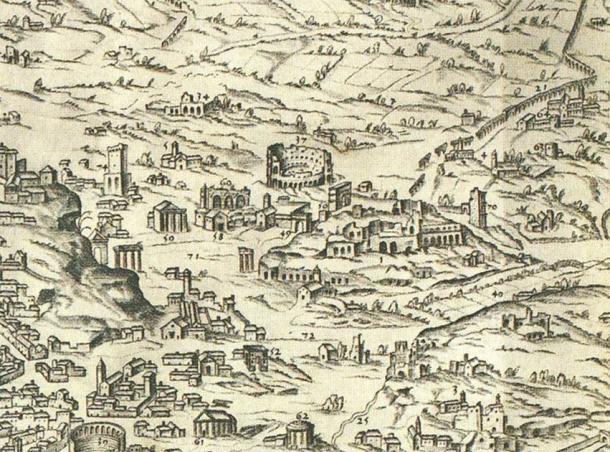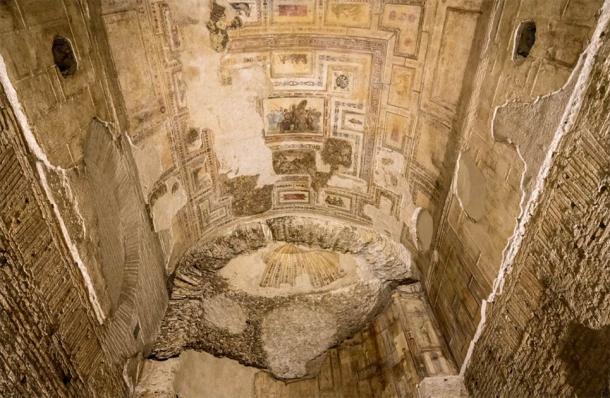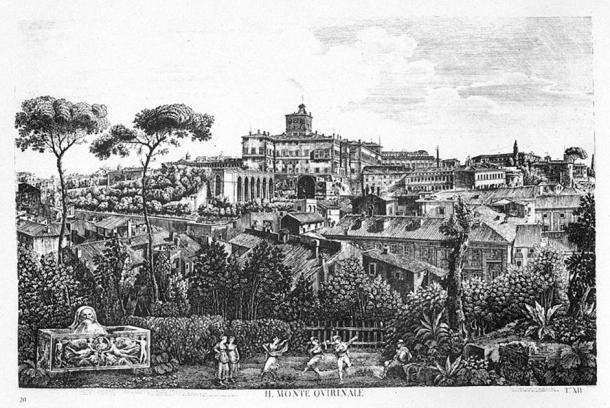The Seven Hills of Rome are a group of hills to the east of the Tiber River, the main river within the city. These hills are important as they are considered the center of the city of Rome, and it was around them that the city was begun back in 753 BC. The seven hills are as follows: Palatine Hill, Aventine Hill, Capitoline Hill, Quirinal Hill, Caelian Hill, Esquiline Hill, and Viminal Hill. Though there are other hills within the city of Rome, it was these seven that formed the crux of civilization when it was begun by its legendary twin founders, Romulus and Remus .

The famous story of Romulus and Remus being raised by the Lupercal, is the backdrop to the founding of Rome. (EmDee / CC BY-SA 4.0)
Romulus and Remus: The Founding of Rome
According to legend, Romulus and Remus were twin sons of the Vestal Virgin Rhea Silvia and the god of war, Mars. However, due to Rhea’s rape by the king of the region, named Amulius, the sons were originally believed to be his and had to be disposed of. The rape of a Vestal Virgin was a capital crime and would result in Amulius’ death if discovered. The twin brothers were thus sent down the Tiber River in a basket, only to wash ashore and be discovered by a wolf, who became known to the Romans as the Lupercal.
The two boys were suckled and raised until they were discovered by a shepherd named Faustulus, who raised them in his own home with his wife. Upon reaching adulthood, the boys determined to depose their “father”, Amulius. Having succeeded, they deciding to build their own culture. Romulus chose to start his city on the Palatine Hill, while his brother Remus built up the Aventine Hill. However, being twins, they could not agree on which one of them should be the primary ruler of their society.
The twins chose to determine the winner by who saw the most eagles in the sky. Romulus watched from his hill, Remus from his. In the end, Romulus slaughtered Remus after Remus trespassed into his territory, unhappy with his brother’s bird-eyed victory, and Romulus was declared the sole ruler of Amulius’ former territory. His hill, the Palatine Hill, thus became the focal point of the new city which eventually came to be called Rome.

Detail of plan of Rome showing the Palatine. ( Peter1936F / CC BY-SA 4.0)
The Hill of Romulus: Palatine
Archaeologically, the Palatine Hill is highly valued as excavations have revealed evidence of settlements dating back to the 10 th century BC, which is before Romulus supposedly founded his city. Thanks to this archaeological evidence, the early Romans are believed to have lived in huts, as the area was rather marshy before the city was drained to provide firmer building grounds. Today, the Palatine Hill is best known for its collection of Republican and imperial residences.
The first emperor, Augustus, built his palace on the Palatine Hill (the name in Latin translates loosely to “palace”), and called it the House of Augustus. Interestingly this house is built in close proximity to the supposed Hut of Romulus, as well as the cave in which the wolf raised him and his brother. This allowed Augustus to maintain close links to the legendary founder of the city and increased his validity to rule. Augustus also built a temple to Apollo near his home. Having improved the aesthetic of Rome, and “left Rome a city of marble”, the association between Augustus and Apollo, the god of the arts, is a prominent association.

Painting by Luca Giordano depicting Aeneas defeating Turnus in revenge for his having murdered Pallas. ( Public domain )
It is also believed, thanks to Virgil’s Aeneid, that the hill was once home to Evander and his son Pallas, both Arcadian Greeks. Pallas was a close friend of Aeneas, the legendary prince of Troy. The two supposedly joined forces and went to war against the Rutuli. Pallas, however, was killed in battle by Turnus. It is Aeneas’ anger over the loss of his close friend which drives him to victory against his enemy. Augustus’ choice to associate with this hill, therefore, also spoke to this earlier myth, linking the fallen Trojan warriors to the successful future awaiting in Rome. Pallas has long been regarded in mythology as a loyal, honest, and brave fighter, and Augustus (and future emperors) building on the site of Pallas’ people only strengthens the connection between the old world and the new.
Other emperors whose homes are located at the Palatine Hill are those of Tiberius, Augustus’ successor, and Domitian, who reigned during the second dynasty of Rome, the Flavian Dynasty. Nero, the last of Augustus’ dynasty, also once had a house on this site, but it burned down in the Great Fire of 64 AD, which he himself was accused of starting.

The Aventine as seen from the Palantine, by Walter T Crane. ( Public domain )
The Hill of Remus: Aventine
The Aventine Hill, the site of Remus’ city, was not originally included within the boundaries of the city of Rome, due in part of Remus’ loss. It was not until the fourth king of the Rome, Ancus Marcius, that the hill came under Roman rule as the site of the Latins who Ancus conquered and moved. Ancus is known for his building programs, including walls, a jail, and the main bridge over the Tiber. His walls were intentionally constructed to widen the borders of Rome and in doing so he included the Aventine Hill.
Aventine Hill is geographically distinctive due to its two peaks, with a depression between the two which later became a boundary separating the hill into two different regions. It is a statement to the foreign deities who were enveloped into the city of Rome, as it is the hill with the most foreign monuments. Also located on this hill was the Armilustrium, which was the site where weapons and armor would be purified after military season had ended. Located as it was on one side of the Circus Maximus, the original site where warriors would gather before battle, the Aventine Hill has a strong association with warfare in the ancient world, making it one of the paramount sites within the growing city. Today it is also known for its monasteries and churches, added to the hill during the Christian period of the city.

Bas relief showing Emperor Marcus Aurelius and his family offering sacrifice at the Temple of Jupiter on the Capitoline Hill. ( MatthiasKabel / CC BY-SA 3.0 )
The Hill of the Head: Capitoline
The Capitoline Hill, located between the Campus Martius and the Roman Forum, was originally the citadel of the city, fortified against attacks and situated firmly within the Servian Walls, the first definitive walls of Rome. It is known historically for the invasion of the Sabines, a neighboring culture during early Rome. During the reign of Romulus, and as part of his quest to expand the small city, he invaded the Sabines.
The settlers in Rome were made up of the predominantly male followers of Romulus, and so they stole the women of the Sabines and took them for wives. In retribution, the Sabines attacked, and were let into the city by a Roman woman called Tarpeia. Following her admittance of the Sabine into the city of Rome, Tarpeia was thereafter remembered by the rock named after her , from which traitors and criminals would be thrown to their deaths. The Sabine women who had been kidnapped eventually stopped the fight, and the two cultures united under peaceful terms, with the Sabines resettling on the Capitoline Hill.

The Rape of the Sabine Women, in a painting by Pietro da Cortona in the Capitoline Museum in Rome. ( Public domain )
Various temples can also be found on the Capitoline Hill, most significantly the Temple of Jupiter Optimus Maximus which was for a long time the most important religious site in the city. It was dedicated toward the end of the Roman monarchy, c. 509 BC, and was rebuilt numerous times over the course of the city’s history. This temple housed images of Juno, Jupiter’s wife and the goddess of marriage, and Minerva, Jupiter’s daughter and the goddess of wisdom and warfare, and formed what is called the Capitoline Triad. These were considered three of the most important gods in the Roman faith, and were frequently depicted together throughout Roman history. Because of their prominent placement on the Capitoline Hill, the depiction of these three gods together were often called Capitolia.

Tarpeia went down in history for having helped the Sabines enter Rome. The same Sabines then crushed her to death with their shields. Tarpeia gave her name to the Taripean Rock, a cliff which is part of the Capitoline Hill, which was used to execute criminals who were thrown off the cliff. ( Sailko / CC BY-SA 3.0 )
Other temples on the Capitoline Hill include the Temple of Saturn (the god of agriculture), the temple to Juno Moneta (Juno the god of of funds and money), and the temple of Virtus (the god of bravery). The Capitoline Hill is also significant in Roman history for being the only hill of Rome to evade capture by the first sack of Rome in 390 BC by the Gauls. It was from this site that the Romans attempted to defend their falling city. Today, the Capitoline Hill has the most extensive collection of ancient and Renaissance works of art in the city of Rome.
An etching of Quirinal Hill in Rome showing the Palzzo del Quirinale. ( Public domain )
The Hill of the Sabines: Quirinal
The Quirinal Hill was historically another site of Sabine settlement. The king of the Sabines lived there to help solidify their new peace with the Romans. The second king of Rome, a Sabine named Numa Pompilius, known for his peaceful ways and association with the wood nymph Egeria, was said to live on Quirinal rather than Palatine. The hill is so named in honor of the Sabine god Quirinus who has often been associated with the Roman god Janus, the god of doorways and boundaries, who was adopted into the Roman religion by a Sabine leader. Today, the hill is the site of the house of Italy’s president, living in the Palazzo del Quirinale.

Caelian Hill is known for its elaborate Republican homes. ( Leonid Andronov / Adobe Stock)
The Hill of the Wealthy: Caelian
The Caelian Hill came to prominence during the reign of the third king of Rome, Tullus Hostilius. Known for his military prowess and his improvements to the early Roman army, Hostilius notably defeated the neighboring culture of Alba Longa c. 7 th century BC. Upon their defeat, he resettled this culture on the Caelian Hill.
In later Roman history, Caelian Hill came to be known for its elaborate Republican homes, as the neighborhood of Rome’s wealthiest citizens. Under the Empire, a temple to the fourth Roman emperor, Claudius, was constructed, and one of the later emperors, Caracalla, built his extensive bath system near here (c. 212 AD). The largest bath system in ancient Rome (at the time), the ruins of the Baths of Caracalla are one of the highlights of Roman culture, providing extensive archaeological evidence of the ancient bath network.

Esquiline Hill is home to the remains of the Domus Aurea, a giant house of gold built by Emperor Nero, and one of the best sources of surviving ancient Roman frescoes. ( steheap / Adobe Stock Photo)
The Hill of Gold: Esquiline
The Esquiline Hill of Rome is the largest hill of the city, and is best known for its role in Emperor Nero ’s Golden House, or Domus Aurea . After the Great Fire of Rome in 64 AD, Nero constructed a giant house of gold on the hill, taking the destroyed land from the residents of the city and repurposing it for himself. His complex also incorporated a giant lake and a large statue of himself called the Colossus, the site of which was later used by Emperor Vespasian for the Colosseum, or Flavian Amphitheater. The Esquiline’s Hill is still being heavily excavated as much of Nero’s Golden House was buried following his death. As such, it is one of the best sources of surviving ancient Roman frescoes.

Landscape painting by Pieter van Bloemen showing the Baths of Diocletian in Rome. ( Public domain )
The Hill of Gods and Baths, Viminal
The smallest of the Seven Hills of Rome is the Viminal Hill. Historically, it is thought to have been the first hill to be included within the city of Rome. Viminal Hill once possessed a temple to the god Serapis, a deity which combined aspects of the Greek Zeus and the Egyptian Osiris, and was erected by Emperor Claudius, c. 41-54 AD. The Baths of Diocletian, begun c. 298 AD, were also constructed near this hill, and replaced the Baths of Caracalla as the largest baths in the city of Rome. More recently, the Viminal Hill was the home to the seat of the Prime Minister of Italy until the 1960s.
The Seven Hills of Rome Today
The Seven Hills of Rome are more than just prominent natural features in Rome’s geographical landscape. They are a testament to Rome’s long history stretching from the early days of its founding on April 21 st, 753 BC to the present day. They have survived years of warfare and political change, and have seen the breadth of religious transition. A visit to Rome is both impossible and incomplete without a historic tour of these seven hills.
Top image: The Seven Hills of Rome are considered to be located in the center of the city. Source: sborisov / Adobe Stock
References
Cary, M. and Scullard, H. H. 1980. A History of Rome: Down to the Reign of Constantine (3rd ed.). Palgrave Macmillan.
Cornell, T. 1995. The beginnings of Rome: Italy and Rome from the Bronze Age to the Punic Wars (c.1000–264 BC) . Routledge.
Gill, N.S. “The 7 Famous Hills of Rome.” Thoughtco.com. Available at: https://www.thoughtco.com/hills-of-rome-117759
Heiken, G, R. Funiciello, D. de Rita. 2013. The Seven Hills of Rome: A Geological Tour of the Eternal City . Princeton University Press.
Ihne, W. 1886. Early Rome: From the Foundation of the City to Its Destruction by the Gauls . New York: Charles Scribner’s Sons. Available at: https://archive.org/details/earlyrome00ihne/page/n9/mode/2up
Livius, Titus. 1922. The History of Rome, Book 5 . Edited by Benjamin Oliver Foster Ph.D. Harvard University Press. Available at: http://www.perseus.tufts.edu/hopper/text?doc=Perseus%3Atext%3A1999.02.0154%3Abook%3D5%3Achapter%3D1
Mathisen, R. W. 2019. Ancient Roman Civilization . New York: Oxford University Press.
Platner, S. B. 1929. A Topographical Dictionary of Ancient Rome . London: Oxford University Press. Available at: https://penelope.uchicago.edu/Thayer/E/Gazetteer/Places/Europe/Italy/Lazio/Roma/Rome/_Texts/PLATOP*/home.htmll
“Seven Hills of Rome.” Culture Trip . Available at: https://theculturetrip.com/europe/italy/articles/what-are-the-seven-hills-of-rome/
“Seven Hills of Rome.” Encyclopedia Britannica . Available at: https://www.britannica.com/place/Seven-Hills-of-Rome
“Seven Hills of Rome.” Italy Magazine . Available at: https://www.italymagazine.com/dual-language/seven-hills-rome
“Seven Hills of Rome: A Brief Overview.” Vatican Tour . Available at: https://www.vaticantour.com/blog/seven-hills-of-rome-a-brief-overview
Related posts:
Views: 0
 RSS Feed
RSS Feed

















 September 12th, 2020
September 12th, 2020  Awake Goy
Awake Goy 
 Posted in
Posted in  Tags:
Tags: 
















